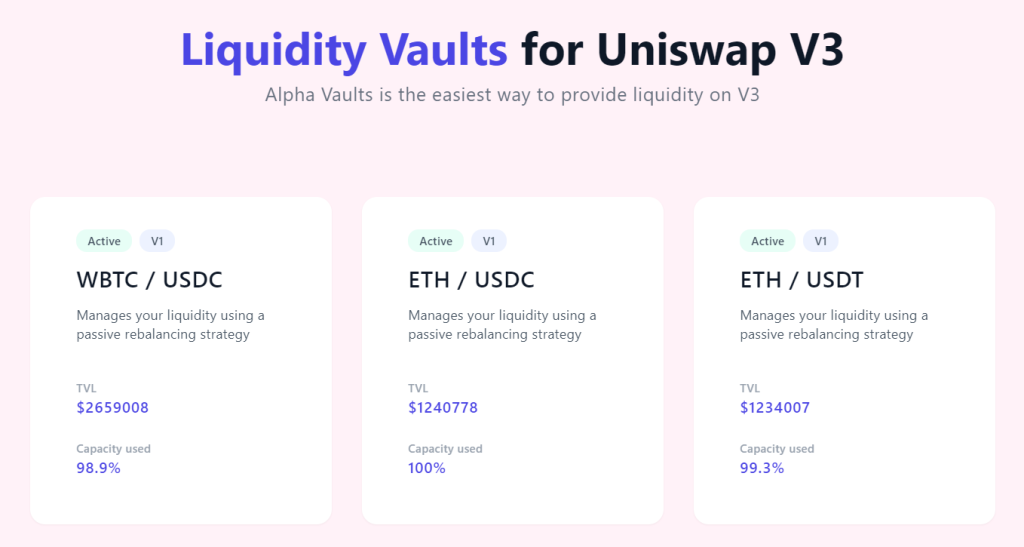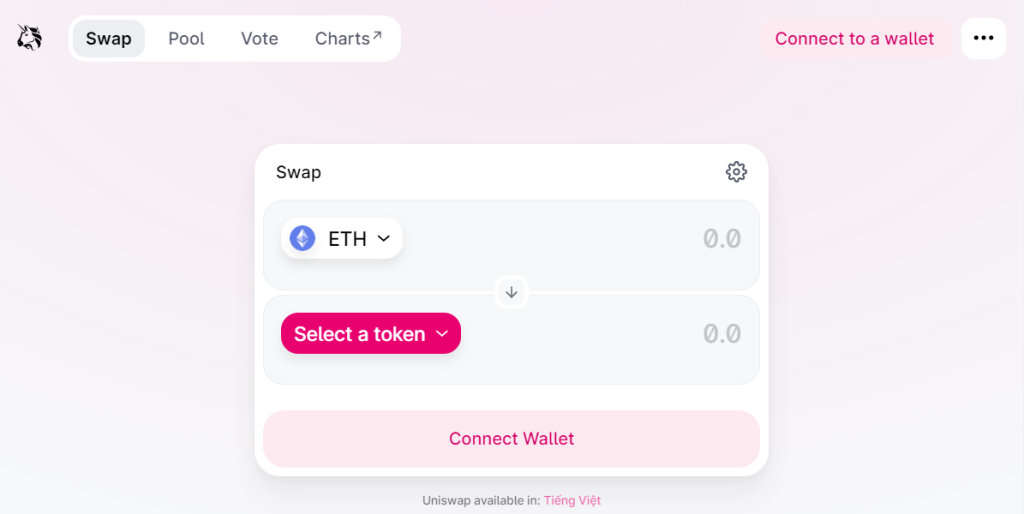
Uniswap V3 and QuickSwap V3 differ primarily in their underlying networks and fee structures. Uniswap V3 operates on Ethereum, offering advanced features like concentrated liquidity and multiple fee tiers but with higher gas fees due to network congestion. QuickSwap V3, on the other hand, runs on the Polygon network, providing similar advanced features with significantly lower transaction costs and faster processing times, making it a more cost-effective option for users.
Platform Overview
Introduction to Uniswap V3
Uniswap V3 is the latest version of the Uniswap decentralized exchange (DEX) protocol, launched on May 5, 2021. It operates on the Ethereum blockchain and introduces several innovative features to enhance liquidity provision and trading efficiency. Key enhancements include concentrated liquidity, which allows liquidity providers (LPs) to allocate their capital within specific price ranges, and multiple fee tiers, giving LPs more flexibility to manage their risk and returns. Uniswap V3 also employs improved price oracles, ensuring more accurate and secure pricing data. As a leading DEX, Uniswap V3 supports a wide range of ERC-20 tokens and has become a cornerstone of the decentralized finance (DeFi) ecosystem.
Introduction to QuickSwap V3
QuickSwap V3 is an advanced iteration of the QuickSwap protocol, a decentralized exchange operating on the Polygon (formerly Matic) network. QuickSwap leverages the low transaction fees and high throughput of the Polygon network to provide a fast and cost-effective trading experience. QuickSwap V3 aims to bring similar innovations as Uniswap V3, such as concentrated liquidity and customizable fee structures, tailored to the Polygon ecosystem. By operating on Polygon, QuickSwap V3 benefits from significantly lower gas fees compared to Ethereum-based DEXs, making it an attractive option for traders and liquidity providers looking to minimize transaction costs while maximizing efficiency. QuickSwap supports a diverse array of tokens, particularly those within the Polygon ecosystem, and has rapidly gained popularity among DeFi users seeking scalable and affordable trading solutions.

Liquidity Provision
Concentrated Liquidity in Uniswap V3
Uniswap V3 introduces a revolutionary approach to liquidity provision with its concentrated liquidity feature. This allows liquidity providers (LPs) to allocate their capital within specific price ranges rather than across the entire price spectrum. Key aspects of this mechanism include:
- Custom Price Ranges: LPs can specify the exact price ranges in which they want to provide liquidity, concentrating their assets around the most active trading prices. This targeted allocation increases the efficiency of capital deployment.
- Higher Capital Efficiency: By concentrating liquidity within narrower bands, LPs can achieve higher returns with less capital compared to traditional liquidity pools. This results in more effective use of resources and potentially higher earnings.
- Dynamic Adjustments: LPs have the flexibility to adjust their positions in real-time in response to market conditions, optimizing their strategies and managing risks more effectively. This dynamic capability enhances the overall liquidity of the platform.
- NFT-Based Positions: Each liquidity position in Uniswap V3 is represented as a non-fungible token (NFT), allowing for unique and customizable liquidity strategies. This innovation provides greater control and flexibility over liquidity management.
Liquidity Mechanism in QuickSwap V3
QuickSwap V3, operating on the Polygon network, adopts a similar approach to liquidity provision as Uniswap V3 but leverages the unique advantages of the Polygon ecosystem. Key features of QuickSwap V3’s liquidity mechanism include:
- Concentrated Liquidity: Like Uniswap V3, QuickSwap V3 allows LPs to concentrate their liquidity within specific price ranges. This feature enhances capital efficiency and provides better control over liquidity deployment.
- Low Transaction Costs: One of the standout advantages of QuickSwap V3 is its operation on the Polygon network, which offers significantly lower transaction fees compared to Ethereum. This makes liquidity provision and trading more cost-effective.
- High Throughput: The Polygon network’s high throughput capabilities ensure that transactions are processed quickly, enhancing the overall user experience and efficiency of liquidity management.
- Customizable Fee Structures: QuickSwap V3 introduces customizable fee tiers, allowing LPs to select the fee structure that best matches their risk tolerance and expected returns. This flexibility helps optimize the profitability of liquidity provision.
- Diverse Token Support: QuickSwap V3 supports a wide range of tokens, particularly those within the Polygon ecosystem. This broad support base attracts a diverse group of users and liquidity providers, fostering a vibrant trading environment.
Fee Structures
Multiple Fee Tiers in Uniswap V3
Uniswap V3 introduces a flexible fee structure that allows liquidity providers (LPs) to choose between different fee tiers based on the volatility and risk of the trading pairs. This system provides better alignment between LP incentives and market conditions. Key aspects include:
- 0.05% Fee Tier: This low fee tier is designed for stablecoin pairs and other low-volatility assets. It encourages high trading volume by minimizing transaction costs, making it suitable for pairs where price stability is expected.
- 0.30% Fee Tier: This is the standard fee tier, suitable for most trading pairs, including major cryptocurrencies. It strikes a balance between offering adequate compensation for LPs and maintaining reasonable trading costs for users.
- 1.00% Fee Tier: This high fee tier is intended for more volatile or exotic assets. It compensates LPs for the increased risk associated with these assets and helps ensure that liquidity is provided for less stable markets.
- Flexible Allocation: LPs can allocate liquidity across multiple fee tiers for the same trading pair, allowing them to optimize their fee earnings based on their risk tolerance and market expectations.
Fee Structure in QuickSwap V3
QuickSwap V3, operating on the Polygon network, offers a fee structure designed to leverage the network’s low-cost transactions while providing flexibility similar to Uniswap V3. Key features include:
- 0.30% Standard Fee: QuickSwap V3 typically uses a standard fee tier of 0.30%, which is competitive and attractive for a wide range of trading pairs. This fee is divided among LPs based on their share of the liquidity pool.
- Lower Transaction Costs: Due to the Polygon network’s low gas fees, the overall cost of trading on QuickSwap V3 is significantly reduced. This makes it more economical for users, even with a standard fee tier.
- Customizable Fee Tiers: Similar to Uniswap V3, QuickSwap V3 is exploring the implementation of multiple fee tiers to cater to different types of trading pairs and market conditions. This feature is expected to provide LPs with more options to tailor their strategies.
- Incentive Programs: QuickSwap V3 may offer additional incentive programs, such as liquidity mining rewards, to attract and retain LPs. These incentives can help offset the costs of providing liquidity and enhance overall returns.

Supported Blockchains
Uniswap V3 on Ethereum
Uniswap V3 operates primarily on the Ethereum blockchain, leveraging its robust ecosystem and extensive user base. Key features and advantages of Uniswap V3 on Ethereum include:
- Network Security: Ethereum is known for its strong security and decentralization, which are critical for the trust and integrity of decentralized finance (DeFi) applications.
- Wide Adoption: As one of the largest and most widely adopted blockchains, Ethereum hosts a vast number of tokens and DeFi projects, providing a rich environment for trading and liquidity provision.
- Smart Contract Functionality: Ethereum’s advanced smart contract capabilities enable the complex functionalities of Uniswap V3, such as concentrated liquidity and multiple fee tiers.
- Ecosystem Integration: Uniswap V3 benefits from deep integration with the Ethereum ecosystem, including wallets, dApps, and other DeFi protocols, enhancing its utility and accessibility.
- Scalability Challenges: Despite its advantages, Ethereum faces scalability issues, leading to higher gas fees and slower transaction times during periods of network congestion. This can affect the cost-efficiency and speed of transactions on Uniswap V3.
QuickSwap V3 on Polygon
QuickSwap V3 operates on the Polygon network, which is designed to address some of the scalability challenges faced by Ethereum. Key features and advantages of QuickSwap V3 on Polygon include:
- Low Transaction Fees: Polygon offers significantly lower transaction fees compared to Ethereum, making it more cost-effective for trading and liquidity provision. This is a major draw for users looking to minimize costs.
- High Throughput: The Polygon network supports high transaction throughput, ensuring faster confirmation times and a smoother user experience, even during periods of high demand.
- Interoperability: Polygon is compatible with Ethereum, allowing seamless asset transfers and interactions between the two networks. This interoperability makes it easier for users and developers to leverage both ecosystems.
- Growing Ecosystem: While still expanding, the Polygon ecosystem includes a growing number of dApps, DeFi projects, and tokens, providing a vibrant environment for QuickSwap V3.
- Scalability Solutions: Polygon employs Layer 2 scaling solutions, such as sidechains and rollups, to enhance its performance and scalability. This makes it a suitable platform for high-frequency trading and DeFi activities.

User Experience
Interface and Usability of Uniswap V3
Uniswap V3 aims to provide a seamless and intuitive user experience, making it accessible for both beginners and advanced users. Key aspects of its interface and usability include:
- Clean Design: Uniswap V3 features a clean and straightforward design, with a user-friendly interface that simplifies the process of swapping tokens and providing liquidity.
- Easy Navigation: The platform is easy to navigate, with clearly labeled tabs for “Swap,” “Pool,” and “Vote,” allowing users to quickly access different functionalities.
- Wallet Integration: Uniswap V3 supports a wide range of wallets, including MetaMask, Trust Wallet, and Coinbase Wallet. Connecting a wallet is straightforward, requiring just a few clicks.
- Advanced Features: For more experienced users, Uniswap V3 offers advanced features like setting custom price ranges for liquidity and choosing different fee tiers. These features are integrated into the interface in a way that is accessible without being overwhelming.
- Real-Time Data: The platform provides real-time data on token prices, liquidity pool statistics, and transaction details, helping users make informed decisions.
- Tutorials and Guides: Uniswap V3 offers comprehensive documentation and guides to help users understand how to use the platform effectively, whether they are swapping tokens or providing liquidity.
Interface and Usability of QuickSwap V3
QuickSwap V3, built on the Polygon network, focuses on providing a fast, cost-effective, and user-friendly experience. Key aspects of its interface and usability include:
- User-Friendly Interface: QuickSwap V3 offers a simple and intuitive interface that is easy to navigate. The design is clean and focused on functionality, ensuring that users can quickly find and use the features they need.
- Low Transaction Costs: One of the standout features of QuickSwap V3 is its low transaction costs, thanks to the Polygon network. This significantly enhances the user experience by making trades more affordable.
- Fast Transactions: QuickSwap V3 leverages the high throughput of the Polygon network to provide fast transaction times, reducing the waiting period for confirmations and improving overall efficiency.
- Seamless Wallet Integration: Like Uniswap V3, QuickSwap V3 supports various wallets, including MetaMask, Trust Wallet, and others. The process of connecting a wallet is user-friendly and secure.
- Clear Functionality: The platform offers clear and accessible features for swapping tokens and providing liquidity. Users can easily see their balance, liquidity positions, and transaction history.
- Educational Resources: QuickSwap V3 provides guides and resources to help users understand how to use the platform, including tutorials on swapping, adding liquidity, and optimizing their DeFi strategies.
- Community Support: QuickSwap V3 benefits from active community support through forums, social media, and help channels, offering users additional assistance and engagement opportunities.

Transaction Costs
Gas Fees in Uniswap V3
Uniswap V3 operates on the Ethereum blockchain, where gas fees can be significant due to network congestion and the complexity of transactions. Here are the key points regarding gas fees in Uniswap V3:
- Variable Gas Fees: Gas fees on Ethereum are variable and can fluctuate based on network demand. During periods of high congestion, fees can become very high, making transactions expensive.
- Impact of Transaction Complexity: More complex transactions, such as providing liquidity or swapping large amounts of tokens, require more computational work, resulting in higher gas fees.
- Gas Fee Optimization: Uniswap V3 has made efforts to optimize gas usage for transactions. Features like concentrated liquidity can help reduce the gas costs per unit of liquidity provided.
- Monitoring Gas Prices: Users can monitor current gas prices using tools like Etherscan’s Gas Tracker or Gas Now to find the optimal time to execute transactions.
- Layer 2 Solutions: To address high gas fees, Uniswap is exploring Layer 2 solutions like Optimistic Rollups and zk-Rollups. These solutions aim to significantly reduce gas costs by processing transactions off the main Ethereum chain.
Gas Fees in QuickSwap V3
QuickSwap V3 operates on the Polygon network, which is designed to offer low-cost transactions, making it a more cost-effective alternative to Ethereum-based platforms. Here are the key points regarding gas fees in QuickSwap V3:
- Low Transaction Fees: Polygon’s network architecture allows for significantly lower gas fees compared to Ethereum. This makes QuickSwap V3 highly attractive for users who want to minimize transaction costs.
- Fixed Gas Prices: Gas prices on Polygon are generally more stable and lower, even during periods of high network activity. This stability ensures predictable transaction costs.
- Efficient Transactions: The high throughput of the Polygon network ensures that transactions are processed quickly and efficiently, further reducing the overall cost and wait times.
- Scalability: Polygon’s Layer 2 scaling solutions effectively manage high transaction volumes without compromising on speed or cost, maintaining low fees across the network.
- User Savings: The lower gas fees on QuickSwap V3 enable users to perform more transactions, such as frequent trades or liquidity adjustments, without worrying about prohibitive costs.

Security Features
Security Measures in Uniswap V3
Uniswap V3 incorporates several advanced security measures to protect user funds and ensure the integrity of the decentralized exchange. Key security features include:
- Immutable Smart Contracts: Uniswap V3 relies on immutable smart contracts deployed on the Ethereum blockchain. Once deployed, these contracts cannot be altered, ensuring that the protocol operates exactly as intended without any risk of tampering.
- Comprehensive Audits: The Uniswap V3 codebase has undergone multiple comprehensive security audits by reputable firms. These audits help identify and address potential vulnerabilities before the protocol is launched.
- Formal Verification: Formal verification techniques are used to mathematically prove the correctness of certain aspects of the smart contracts. This reduces the likelihood of bugs or vulnerabilities in critical components.
- Minimal Governance: Uniswap V3 operates with minimal governance, reducing the risk of governance attacks and ensuring that the protocol remains decentralized and resistant to manipulation.
- Emergency Shutdown Mechanisms: The protocol includes mechanisms to pause or disable certain functions in the event of a security breach or other critical issues. This allows for quick responses to unforeseen threats.
- Price Oracle Security: Improved price oracles in Uniswap V3 provide more accurate and secure price data, reducing the risk of manipulation and ensuring fairer trading conditions.
Security Measures in QuickSwap V3
QuickSwap V3, built on the Polygon network, also emphasizes robust security features to safeguard user funds and maintain the platform’s integrity. Key security features include:
- Layer 2 Security: Polygon’s architecture leverages Ethereum’s security while providing additional scalability. This dual-layer approach enhances overall security while maintaining efficiency.
- Smart Contract Audits: Like Uniswap, QuickSwap V3 undergoes regular security audits by third-party firms to ensure the integrity and safety of its smart contracts. These audits help identify and mitigate potential vulnerabilities.
- Decentralized Governance: QuickSwap V3 employs a decentralized governance model, allowing the community to propose and vote on changes. This ensures that no single entity has control over the protocol, reducing the risk of centralization and manipulation.
- Multi-Signature Wallets: QuickSwap employs multi-signature wallets for protocol administration, ensuring that multiple parties must approve critical transactions, thereby reducing the risk of unauthorized actions.
- Rapid Response to Threats: The QuickSwap team is committed to rapid identification and response to any security threats. This includes deploying fixes and updates promptly to address vulnerabilities.
- Price Stability and Oracle Security: QuickSwap uses secure and reliable price oracles to ensure accurate price feeds, which are crucial for maintaining fair and transparent trading conditions on the platform.